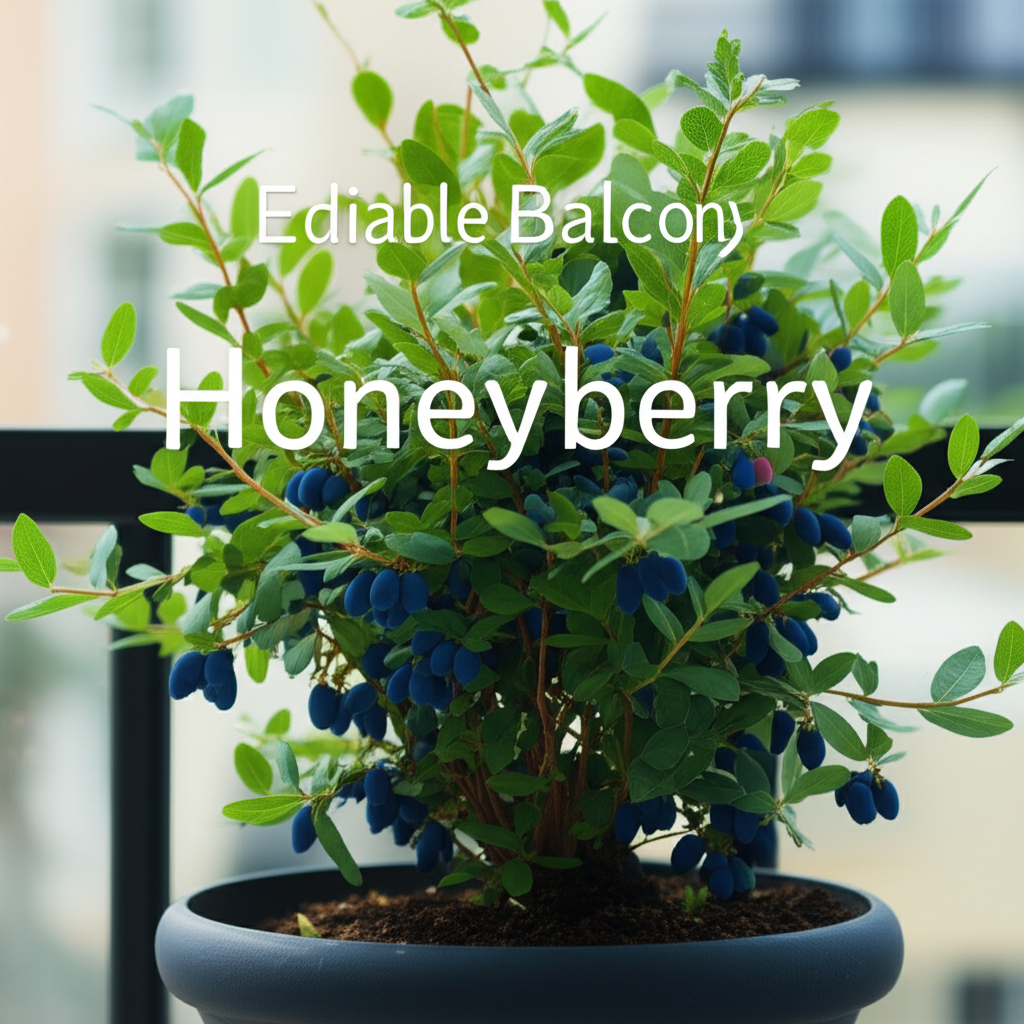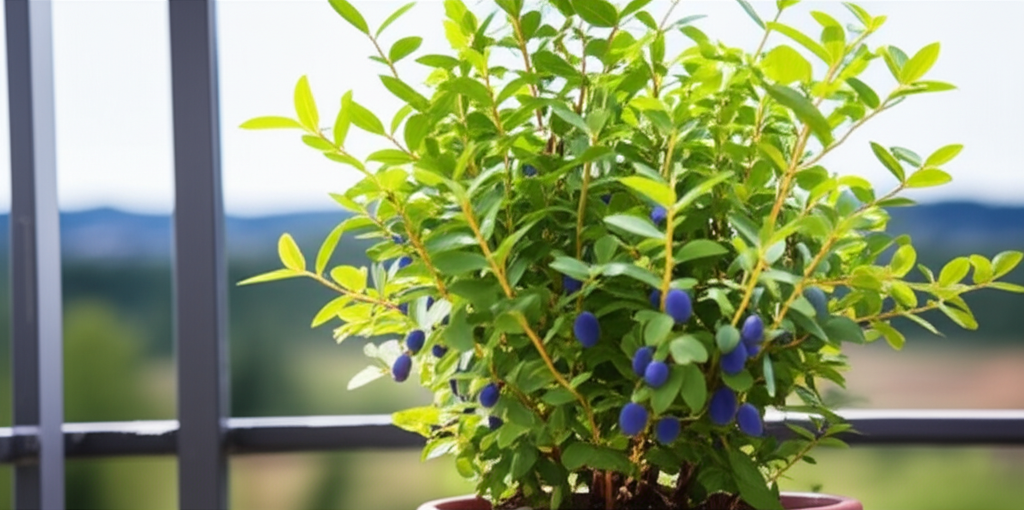The Rise of the Edible Balcony Garden
In urban environments, the desire to connect with nature and cultivate our own food has led to a surge in balcony gardening. Even the smallest urban oasis can be transformed into a productive and aesthetically pleasing edible garden. While many associate balcony gardening with herbs and small vegetables, the world of fruit-bearing plants offers a rewarding, albeit sometimes challenging, opportunity. Among the most promising candidates for this compact cultivation is the honeyberry shrub, a hardy and delicious newcomer to the gardening scene.
Introducing the Honeyberry (Haskap) Shrub

Honeyberry, also known by its Japanese name Haskap or its scientific name Lonicera caerulea, is a deciduous shrub belonging to the honeysuckle family. Don’t let the familiar “honeysuckle” name fool you; these are not the ornamental, often overly fragrant varieties. Honeyberry shrubs are cultivated for their uniquely flavored, elongated berries, which offer a tantalizing blend of blueberry, raspberry, and plum notes.
What makes honeyberries particularly well-suited for balcony gardening is their remarkable resilience. They are exceptionally cold-hardy, tolerating temperatures well below freezing, making them ideal for climates with harsh winters. Furthermore, they are relatively low-maintenance, adaptable to various soil conditions, and often self-pollinating, though planting multiple varieties can significantly improve fruit yield.
Why Honeyberries are Perfect for Balcony Gardens
Balcony gardens present unique challenges: limited space, potential for strong winds, and varying sunlight exposure. Honeyberry shrubs address many of these concerns:
- Compact Growth Habit: While some varieties can reach several feet in height and width, many are bred for more manageable, compact growth, making them suitable for container cultivation.
- Cold Hardiness: Their ability to withstand extreme cold means they can remain outdoors year-round in many urban climates, simplifying overwintering.
- Adaptability: Honeyberries are forgiving plants, tolerating a range of soil pH and types, which is beneficial when dealing with potting mixes.
- Early Season Fruit: Honeyberries are among the earliest fruits to ripen, often producing their bounty in late spring or early summer, providing a welcome taste of freshness before many other fruits are ready.
- Pollination: While some varieties are self-fertile, planting two or more different cultivars significantly enhances cross-pollination and thus, fruit production.
Key Facts About Honeyberry Shrubs
To understand why honeyberries are a stellar choice for your balcony, consider these essential facts:
| Feature | Honeyberry (Lonicera caerulea) |
|---|---|
| Common Names | Honeyberry, Haskap, Blue Honeysuckle, Edible Honeysuckle |
| Origin | Northern Hemisphere (Siberia, Canada, Japan) |
| Fruit Flavor Profile | Sweet and tart, with notes of blueberry, raspberry, and plum |
| Ripening Time | Late Spring to Early Summer (May-July) |
| Cold Hardiness | Very High (USDA Zones 2-9) |
| Sunlight Requirements | Full Sun to Partial Shade (best fruit production in full sun) |
| Soil Requirements | Well-draining, slightly acidic to neutral pH |
| Pollination | Cross-pollination recommended for best yields; some varieties are self-fertile |
| Growth Habit | Deciduous shrub, typically 3-6 feet tall and wide (can vary by cultivar) |
| Container Suitability | Excellent, with appropriate pot size and care |
Choosing the Right Honeyberry Cultivar for Your Balcony
The selection of the right cultivar is crucial for success, especially in a confined space. Breeders have developed numerous varieties, each with distinct characteristics in terms of size, fruit production, and flavor. When choosing, consider:
- Mature Size: Opt for dwarf or semi-dwarf varieties that won’t outgrow your balcony space.
- Pollination Compatibility: If you plan to grow only one plant, look for a self-fertile variety. However, for better yields, it’s highly recommended to grow at least two compatible cultivars. Research which varieties cross-pollinate best.
- Disease Resistance: Some cultivars are more resistant to common diseases, which can be beneficial in a more humid balcony environment.
- Flavor and Use: Some berries are sweeter, others tarter, and some are better suited for fresh eating while others excel in jams and preserves.
Popular Honeyberry Cultivars for Containers:
- ‘Borealis’: Known for its large, sweet-tart berries and good self-fertility, making it a great choice for a single-plant balcony garden. It has a relatively compact growth habit.
- ‘Tundra’: Another excellent self-fertile option with large, firm berries that hold up well. It’s generally hardy and productive.
- ‘Honey Bee’: A vigorous grower with good yields of flavorful berries. It benefits from cross-pollination.
- ‘Aurora’: Produces large, sweet berries and is a good pollinator for other varieties.
- ‘Indigo Gem’: Known for its attractive blue foliage and sweet, elongated berries. It requires cross-pollination.
Cultivating Honeyberries on Your Balcony: A Step-by-Step Guide
Successfully growing honeyberries in containers on a balcony involves careful planning and execution.
1. Selecting the Right Container
The foundation of successful container gardening is the container itself.
- Size: Start with a pot that is at least 15-20 gallons (approximately 18-24 inches in diameter and depth) for a young shrub. As the plant grows, you may need to repot it into a larger container, ideally 25-30 gallons. Adequate root space is essential for healthy growth and fruit production.
- Material: Choose pots made of durable materials like heavy-duty plastic, fiberglass, or ceramic. Ensure the pots are frost-proof if you live in a cold climate, as freezing and thawing can crack thinner materials.
- Drainage: This is paramount. The container must have ample drainage holes to prevent waterlogging, which can lead to root rot. If the pot doesn’t have enough, drill more.
2. Potting Mix and Soil Preparation
Honeyberries prefer well-draining soil with a slightly acidic to neutral pH (5.5-7.0).
- Mix: A good quality potting mix specifically designed for containers is recommended. You can enhance drainage and aeration by adding perlite or coarse sand.
- Amendments: For a slightly acidic balance, you can incorporate a small amount of peat moss or compost. Avoid heavy garden soil, as it compacts too easily in containers and hinders drainage.
3. Planting Your Honeyberry Shrub
- Timing: The best time to plant is in early spring, after the last frost, or in early fall.
- Depth: Plant the shrub at the same depth it was in its nursery pot. The top of the root ball should be level with the soil surface.
- Spacing (if planting multiple): If you’re planting two or more shrubs in separate large containers on your balcony, ensure they have adequate space to grow without overcrowding.
4. Watering Needs
Consistent moisture is key for container-grown plants.
- Frequency: Water thoroughly when the top inch or two of soil feels dry to the touch. This might mean watering daily during hot, dry periods.
- Method: Water at the base of the plant, ensuring the entire root ball is moistened. Avoid overhead watering, which can promote fungal diseases.
- Drainage Check: Always check that excess water drains freely from the pot.
5. Sunlight and Location
- Sunlight: Honeyberries thrive in full sun, requiring at least 6-8 hours of direct sunlight daily for optimal fruit production. If your balcony only receives partial shade, choose a location that gets the most sun exposure throughout the day.
- Wind Protection: Balconies can be windy. Consider a sheltered location or use a windbreak to protect your plants from strong gusts, which can dry them out quickly and damage tender growth.
6. Fertilizing
Container plants rely entirely on you for nutrients.
- Type: Use a balanced, slow-release fertilizer formulated for fruit-bearing plants.
- Timing: Apply fertilizer in early spring as new growth emerges. Follow the product instructions for dosage. You may need to fertilize again in mid-summer.
7. Pruning
Pruning helps maintain the shrub’s shape, encourages new growth, and improves fruit production.
- When: Prune in late winter or early spring, before new growth begins.
- What: Remove any dead, damaged, or crossing branches. You can also thin out older, less productive stems to encourage new, vigorous growth. Aim for an open structure that allows for good air circulation.
8. Overwintering on the Balcony
Due to their extreme cold hardiness, honeyberries can often remain on the balcony year-round.
- Protection: While the plant itself is hardy, the roots in containers are more vulnerable to freezing. To protect them, insulate the pots. You can wrap the pot in burlap, bubble wrap, or move it to a more sheltered corner of the balcony.
- Watering: Reduce watering during winter months, only watering if the soil becomes excessively dry.
Harvesting Your Delicious Honeyberries
The anticipation of the harvest is one of the most rewarding aspects of growing your own fruit.
- When to Harvest: Honeyberries are ripe when they have a uniform blue color, are slightly soft to the touch, and detach easily from the stem. This typically occurs in late spring or early summer.
- How to Harvest: Gently pluck the berries from the bush. They are quite delicate and can bruise easily.
Beyond the Berry: Benefits and Uses
Honeyberries are not just a joy to grow; they are packed with nutritional benefits and culinary versatility.
Nutritional Powerhouse
These little berries are an excellent source of:
- Antioxidants: Rich in anthocyanins (which give them their deep blue color) and other antioxidants, honeyberries help combat free radical damage in the body.
- Vitamins: They contain Vitamin C, Vitamin A, and several B vitamins.
- Fiber: A good source of dietary fiber, aiding digestion.
- Minerals: They also provide essential minerals like potassium and manganese.
Culinary Delights
Honeyberries can be enjoyed fresh or used in a variety of dishes:
- Fresh Eating: Their unique sweet-tart flavor makes them a delightful snack straight from the bush.
- Jams and Jellies: Their high pectin content makes them ideal for setting into delicious jams and jellies.
- Smoothies and Juices: Blend them into smoothies or extract their juice for a vibrant, nutrient-rich drink.
- Baking: Incorporate them into pies, tarts, muffins, and crumbles.
- Sauces and Toppings: Create sauces for desserts or savory dishes, or use them as a topping for yogurt or ice cream.
Potential Challenges and Troubleshooting
While honeyberries are generally low-maintenance, container gardening on a balcony can present specific issues.
| Problem | Cause | Solution |
|---|---|---|
| Yellowing Leaves | Overwatering or underwatering; nutrient deficiency | Check soil moisture. Adjust watering schedule. Fertilize with a balanced liquid fertilizer if deficiency is suspected. |
| Poor Fruit Production | Lack of cross-pollination; insufficient sunlight; plant is too young | Ensure you have at least two different compatible cultivars. Move the plant to a sunnier location. Be patient; plants often take a few years to establish and produce well. |
| Wilting | Underwatering; root rot from overwatering | Check soil moisture. If overwatered, allow soil to dry out and ensure good drainage. If underwatered, water thoroughly. |
| Pests (e.g., aphids, spider mites) | Stress from environmental conditions; lack of natural predators | Inspect plants regularly. Blast pests off with a strong jet of water. Use insecticidal soap or neem oil if infestation is severe. Encourage beneficial insects if possible. |
| Fungal Diseases | Poor air circulation; excessive humidity; overhead watering | Prune to improve air circulation. Avoid overhead watering. Remove affected leaves promptly. |
The Future of Urban Edible Gardening
The honeyberry shrub stands as a testament to the potential of urban edible gardening. Its resilience, compact nature, and delicious fruit make it an exceptional choice for balcony enthusiasts looking to expand their harvest. By selecting the right varieties, providing proper care, and embracing the unique challenges of container living, you can enjoy the sweet reward of your own homegrown honeyberries, bringing a taste of nature’s bounty right to your doorstep.
Conclusion: A Sweet Addition to Your Urban Sanctuary
Adding a honeyberry shrub to your edible balcony garden is more than just planting a fruit bush; it’s an investment in a rewarding, delicious, and sustainable gardening experience. With their ability to thrive in containers and their early-season harvest, honeyberries offer a unique advantage for urban growers. Embrace the simplicity and sweetness of these remarkable berries and transform your balcony into a productive, edible sanctuary.


